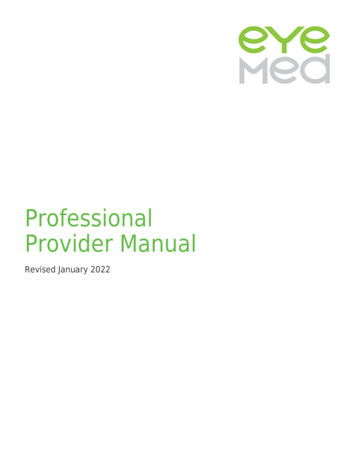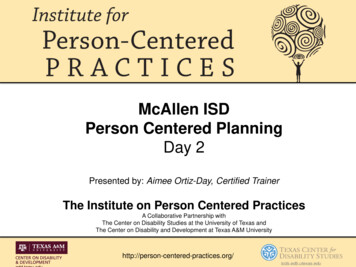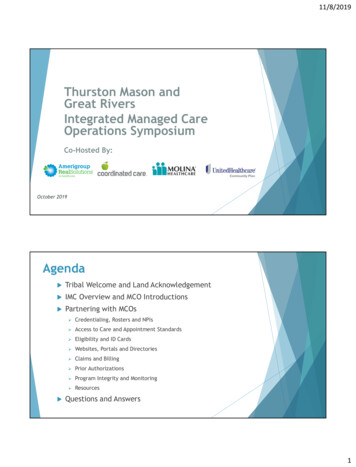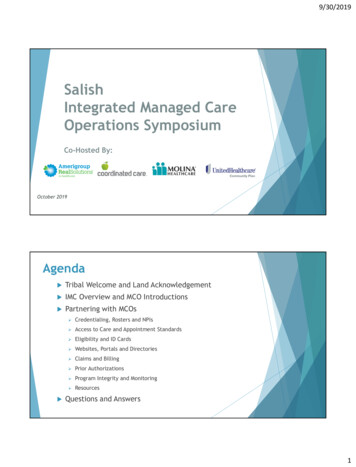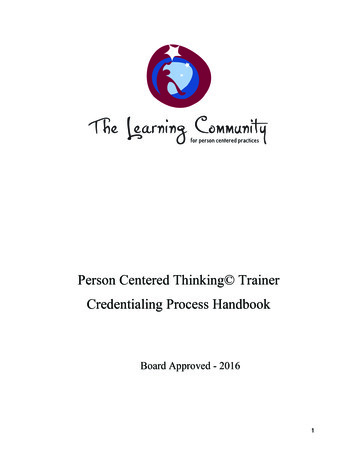
Transcription
Person Centered Thinking TrainerCredentialing Process HandbookBoard Approved - 20161
Getting StartedCongratulations on taking this step towards becoming a Person Centered Thinking (PCT )Trainer. This designation is an internationally recognized level of achievement within TheInternational Learning Community for Person Centered Practices (ILCPCP).Please review all the material set out in this handbook to ensure that you have the informationyou will need to continue on. Contact a Mentor Trainer with the ILCPCP for suggestions onhow to fulfill the Foundational Requirements and Prerequisites and to make arrangements fortheir support throughout the credentialing process. Approved Mentor Trainers are listed on theILCPCP website at www.learningcommunity.usPerson Centered Thinking Trainer Certification is required to also train Person CenteredThinking Coaches, and/or to be certified as a Person Centered Plan Facilitator Trainer.Note: This credentialing process is related to certification for the 2 Day Person CenteredThinking curriculum. Person Centered Plan Facilitation, PCT Coaches Training, PCTFamily Training, and People Planning Together, each have credentialing processes andrequirements. Check the ILCPCP website for more information on these certifications.Foundational RequirementsPrerequisitesThe Person Centered Thinking Trainer Candidate: Must have lived experience either through their personal life or work with the targetaudience/sector for which they are becoming Trainers.Must have participated in a full 2-day Person Centered Thinking Training, and be using theskills in day-to-day work.Must have the commitment to the time and effort needed to master the skills and develop theability to train effectively.Must have passion for supporting people in a person centered manner, and willingly sharethat passion with others.Must be willing to contribute to The International Learning Community for Person CenteredPractices and attend a Gathering.Must be willing to become a member in good standing with access to the ILCPCP Trainer’ssection of the ILCPCP website.Must be familiar with and have a willingness to embrace and support the ILCPCP Board’sVision, Mission and Plan.CompetenciesThe Person Centered Thinking Trainer Candidate must have skills sufficient to communicateeffectively with the training audience. This includes having the skills to use verbal enhancersthat more fully communicate and explain essential concepts and information, including examplesand illustration, creative phrasing, analogies, quotation, rhetorical questions, and comparing andcontrasting concepts. He/she must have demonstrated experience with training groups of adults.2
The Person Centered Thinking Trainer Candidate must know strategies to engage and involveparticipants who display resistance or lack of involvement, or who exhibit disruptive behaviorsthat interfere with the development of constructive group process. He/she must havedemonstrated experience with managing group dynamics.3
Detailed Credentialing ProcessACTIONPREREQUISITESTAGE 1Agreement& PracticeAttend a 2-day PersonCentered Thinkingtraining AND put yourlearning to immediatepracticeAsk yourselfPreparingto TrainBegin using the tools you have learned with the people (orperson) you support. These experiences should be capturedon the Person Centered Thinking Trainer Candidate Portfolio(section IV of this document)! Am I familiar with the ILCPCP Board’s Vision, Missionand Plan! Am I committed to supporting people in a personcentered manner?! Can I effectively communicate that to others?! Do I have experience training groups of adults?! Do I have experience managing group dynamics?! Am I willing to commit to the time & effort required tobecome certified?! Am I willing to contribute to The International LearningCommunity for Person Centered Practices and attend aGathering?! Am I willing to become a member in good standing withaccess to the ILCPCP Trainer’s section.! Do I have my employer’s support for the time andresources needed in obtaining and maintaining mycertification or am I committed to absorbing the costsmyself?PURPOSETIME/ REQUIREDReal-life, on-going use of the tools isrequired of every certified trainer.-2 full days practice-Registration feeDelivering PCT training is more thanjust standing in front of an audience anddelivering a canned speech with aPowerPoint. Rather, it is teaching toolsto a diverse audience with varyingbackgrounds, interest levels, andinterests. We are invested in ensuringgood training that helps people havebetter lives, not just better paper.-Your time andpersonalintrospection6-10 hoursContact a MentorTrainerMentors are listed on the following website:http://www.learningcommunity.us (click on a country, then astate/province and look for names of mentor trainers)Certification is not possible without aMentor Trainer. Failure to contact aMentor early in your process may meanyou have to repeat steps unnecessarily.-The price of aphone call or anemail and your timeEnter in agreement withMentor Trainer toembark on thecredentialing processThe agreement may be a formal (typed and signedagreement) or informal (verbal) based on the Mentor Trainer’spractice and own employment requirements.The Mentor will ensure that you havetaken the necessary steps to begin thecertification process. We don’t wantyou wasting time/effort unnecessarily.Document the ways you use the tools and what you learn fromyour practice. For each tool, capture detailed information in aword document (use the chart as your guide of the informationneeded) and add checkmarks to the portfolio chart as youcomplete each component. Submit the completed tools anddetailed notes along with your portfolio to your Mentor.The Mentor will review each tool toensure that you fully understand thetools and how to use them. They willprovide you with feedback as well asmentoring if needed.- Mentoring Fee forentire process- all Mentor travelexpenses orconferencecall/long distancecalling costsYour Mentor will provide you with the Two-day PersonCentered Thinking Trainer’s Guide and other trainingmaterials. You will have opportunity to discuss your questionsand review your observations with Mentor after the session.* Take note:" Training techniquesThis stage provides you the opportunityto observe the training thru the trainer’seyes, with the scripted curriculum infront of you. See how questions areanswered, time frames are managed,and activities are facilitated.Document yourPractice – beginPortfolioSTAGE 2SPECIFIC STEPSObserve PCT Training"Trainer Candidatescan work in pairs.Talk with yourMentor aboutworking with a Co-20-40 hours-Trainer’s Guide(materials fee)-2 days to observetraining discussion/question& answer time withmentor – Trainer4
Trainer Candidate.Meet with Mentor toprepare for your firstTraining demonstrationSelf-study of materials,notes and logisticsSTAGE 3PracticeDeliver PCT Trainingwith Mentor Trainer ORwith another TrainerCandidate." Candidates arerequired to deliverthe training TWOtimes (more may berequired based onlevel of competenceand readiness)Meet with MentorTrainer (in person or byphone/email) to reviewand evaluate yourprogress." Examples, stories, & activities" Effective management of questions and concerns" Time managementReview & discuss with Mentor after session." Develop your learning planst" Receive support preparing for your 1 demonstration" Determine if you will be delivering the training alone, withanother trainer candidate or with the Mentor" Review logistics requirements, including registrationprocess for participants, location, materials preparationand printing, electronic equipment i.e. lap top, projector,speakers, etc." Determine when/how your Mentor will support you andassist with the actual training session if needed" Expand your knowledge of material, sequence, learningobjectives, and time frames" Organize your materials" Gain insight into the training activities and how tofacilitate them successfully" Familiarize yourself with The International LearningCommunity’s website" Practice delivering the training and facilitating theexercises (in front of friends, family, a few co-workers, infront of a mirror, by video-taping yourself, etc.)" If you are co-training, work with your Co-Trainer todetermine which sections will be trained by whom andhave this reviewed and agreed by your Mentor" With your Co-Trainer, determine how transitions willoccur and how you will support each otherMust be observed by a mentor trainer" Demonstrate knowledge of materials and presentationmethods" Demonstrate skills: Communicating instructions Managing diverse audiences, backgrounds, andinterest levels Answering questions, facilitating learning Effective time management" Discuss & review with Mentor trainer at the end of eachsession (or as needed)" Mentor will provide written comments andrecommendations" Review current status and ensure all steps have beencompleted to Mentor’s satisfaction" Review requirements for ongoing certification" Complete/Update your Trainer’s One Page Profile" Review and sign Standards of Practice declarationCandidate & MentorThe devil is in the details! You will do aminimum of 2 demonstrations prior tocredentialing. Good preparation willmake each demo easier to deliver.- Meet in person, orvia phone/email -Your familiarity with the script, logistics,training materials, and how to facilitatethe stories and activities will be a criticalcomponent to your success when it’stime to deliver the training.-Mentor Traineravailable viaphone/emailEffective delivery of this materialrequires a strong knowledge of theTwo-day Person Centered Thinking Trainers’ Guide, Linked Exercises andplenty of experience in the practicalapplication of the tools. Practicing yourdelivery will give you opportunities to:" Address typical sticking points forparticipants and help themthrough the learning." Answer challenging questionsfrom participants." Adjust timeframes as needed" Experience the intricacies of usingthe training activitiesAn opportunity to ask any furtherquestions, to address any concerns,and to review the requirements forcontinued certification beyond your firstyear.-4 Full days lunchdiscussion andreview at the end ofthe session –Trainer Candidate &Mentor Trainer3hours – 1 day (asneeded)Minimum 20 hours- 1-3 hours (inperson, or viaphone/email) –Trainer Candidate &MentorThe checklist found on the following pages can be helpful in keeping track of your credentialing process.5
Maintaining PCT Trainer CertificationAll PCT Trainers who desire to maintain their credentials as a Person Centered Thinking Trainermust:!Write 2 One Page Profiles per year that meet best practices. (resource attached)!Deliver the full 2 days of Person Centered Thinking Training at least 2 times per yearand/or use all curriculum components to train in a context suitable to own circumstances atleast 2 times per year. There are many possible ways to facilitate PCT training outside ofthe traditional boxes. You must keep a log of each curriculum component deliveredincluding the date it was delivered.!Stay current by completing one or more of the following each year:o Attend a Gathering endorsed by The International Learning Community for PersonCentered Practices that includes a Trainers’ session and/oro Attend a session with a Mentor Trainer to obtain updated training curriculum andILCPCP information as well as have an opportunity to further developskills/knowledge through activities/exercises. This could be done in person orremotely and includes an opportunity for questions, discussion and networking withthe mentor and possibly other trainers and/oro Have individual discussions with Mentor Trainer on changes tocurriculum/materials/supplies/etc.*Please note that Mentors may need to charge a fee for this in order to cover theirexpenses and time.!Be a member in good standing by:o Meeting the requirements to stay current as described aboveo Reading and sign the Standards of Practice declarationo Paying your annual Trainer’s fee to the ILCPCP. The fee gives you:" Access to the current PCT curriculum" The right to list your information on the ILCPCP website" The right to belong to the Trainers’ subgroup on The International LearningCommunity website." Permission to continue delivering the training!Share with the ILCPCP knowledge, experience, innovation and learning gained throughoutthe year. This can be done by making a contribution in the following ways:o Share your information or ask questions via the ILCPCP websiteo Upload your best practice resources to the ILCPCP websiteo Get involved in a ILCPCP gathering by presenting or helping in theorganization/planning of the gathering!Contribute to requests for comment on new exercises/trainings/learning methods developedRegaining Status After It Has Elapsed6
If a Trainer has not met the yearly trainingrequirements to maintain their credentials, the Trainerneeds to be observed by a Mentor Trainer delivering the latest 2-day curriculum and demonstrateknowledge and skill in order to regain their credentials.Other Credentialing OptionsTraining in A New-To-You SectorIf a 2-day Person Centered Thinking Trainer is in good standing and wishes to train in a sectorthat is new to them i.e. Aging, Mental Health, Homelessness, etc. they need to gain contextknowledge and develop their experience by:!!!Spending time with a Mentor Trainer who has experience in this sector and can shareexamples and stories that are more suited for the target audience as well as provideinsight in terms of context for this sectorResearching this new sector to gain understanding of current context, issues, practices,etc. This can be done by discussing the following with the organization that is asking forthe training:o What are their learning objectives?o What is the general knowledge base of the group regarding Person-CentredThinking and Planning?o Is there a sense of optimistic or cynical discontent about change in theorganization?Collaborating with someone who has expertise in this sector to fully understand the needsof the target audience. This can be done with the organization requesting the training oranother organization providing the same type of supports and can include:o Meeting people supported by the organizationo Learning some of the language used in this service sector1 Day Curriculum for E-LearningIf a 2-day Person Centered Thinking Trainer is in good standing and wishes to becomecredentialed in the 1-day curriculum that is part of an e-learning, they need to:1.2.3.4.Complete the e-learningSpend time with a 1day curriculum Mentor Trainer to review the curriculum and beobserved presenting the 1-day workshop by a Mentor TrainerCreate a One Page Profile as a PCT TrainerFollow the requirements to stay credentialed and be in good standing as a 2 Day PCTTrainer.7
What's Your Learning Style?(This is an optional discovery about your learning style. Completion of this is not required as a part of the routine 2 Day PCT Trainercertification process.)Learning styles refer to the ways you prefer to approach new information. Each of us learns and processesinformation in our own special ways, though we share some learning patterns, preferences, and approaches.Knowing your own style also can help you to realize that other people may approach the same situation in adifferent way from your own.Take a few minutes to complete the following questionnaire to assess your preferred learning style. Begin byreading the words in the left-hand column. Of the three responses to the right, circle the box that bestcharacterizes you, answering as honestly as possible with the description that applies to you right now. Count thenumber of circled items and write your total at the bottom of each column. The questions you prefer will offerinsight about how you learn.1. ConcentrationDoes seeing clutter ormovement distract you? Doyou notice things around youthat other people don’t?Are you distracted by sounds ornoises? Do you control theamount and the type of noisearound you?Are you distracted by activityaround you? Do you shut outconversations and go insideyourself?2. VisualizingDo you see clear, detailedpictures in your thoughts?Do you think in sounds andvoices?Do the images you see in yourthoughts involve movement?3. TalkingIs it hard for you to listen fora long time? Do you often usewords such as see, picture,and imagine?Do you enjoy listening? (Or,maybe, you’re impatient totalk?) Do you often use wordssuch as say, hear, tune, andthink?Do you like to gesture and talkwith your hands? Do you oftenuse words such as feel, touch,and hold?4. Contacting peopleDo you prefer direct, face-toface, personal meetings?Do you prefer the telephone forserious conversations?Do you prefer to talk whilewalking or participating in anactivity?5. Meeting someoneagainDo you forget name butremember faces? Can youusually remember where youmet someone?Do you tend to rememberpeople’s names? Can youusually remember what youtalked about?Do you tend to remember whatyou did together? Can youalmost feel your time together?6. RelaxingDo you prefer to watch TV,see a play, go to a movie?Do you prefer to listen to theradio, play music, read, talkwith a friend?Do you prefer to play sports,make crafts, build somethingwith your hands?7. ReadingDo you like descriptivescenes? Do you pause toimagine the storyline?Do you enjoy the conversationmost? Can you “hear” thecharacters talk?Do you prefer action stories?(Or, maybe don’t even enjoyreading for pleasure?)8. SpellingDo you try to see the word inyour mind? Do you imaginewhat it would look like onpaper?Do you use a phonetics andspelling rules to sound out theword? Do you hear it in yourthoughts or say it aloud?Do you write down the word tofind out if it feels right? Maybeyou run your finger over it ortype it out?8
9. Doing somethingnew at workDo you like to seedemonstrations, diagrams,and flow charts? Do you seekout pictures or diagrams?Do you find verbal and writteninstructions helpful? Do youlike talking it over? Do you aska friend or someone sitting nextto you?Do you prefer to jump right inand try it? Do you keep trying?Do you try different ways?10. Puttingsomething togetherDo you look at the picture andthen, maybe, read thedirections?Do you like reading or talkingwith someone about it? Do youfind yourself talking aloud asyou work?Do you usually ignore thedirections and figure it out asyou go along?11. InterpretingmoodDo you mostly look at facialexpressions?Do you listen to the tone ofvoice?Do you watch for bodylanguage?12. Teaching peopleDo you prefer to show them?Do you prefer to tell them?Write it out?Do you demonstrate how it’sdone? Ask them to try it?Visual:Auditory:Tactile/Kinesthetic:TotalThe column with the highest total represents your primary processing style. The column with the second-mostchoices is your secondary style.Your primary learning style:style:Your secondary learningNow that you know which learning style you rely on, you can boost your learning potential when working to learnmore. For instance, the following suggestions can help you get more from reading a book.If your primary learning style is visual, draw pictures in the margins, look at the graphics, and read the text thatexplains the graphics. Envision the topic or play a movie in your thoughts of how you’ll act out the subject matter.If your primary learning style is auditory, listen to the words you read. Try to develop an internal conversationbetween you and the text. Don’t be embarrassed to read aloud or talk through the information.If your primary learning style is tactile/kinesthetic, use a pencil or highlighter pen to mark passages that aremeaningful to you. Take notes, transferring the information you learn to the margins of the book, into yourjournal, or onto a computer. Doodle whatever comes to mind as you read. Hold the book in your hands instead ofplacing it on a table. Walk around as you read. Feel the words and ideas. Get busy—both mentally and physically.More information on each style, along with suggestions on how to maximize your learning potential, isavailable in the book Learn More Now (Hoboken, NJ; John Wiley & Sons, 2004).(c) Marcia L. Conner, 1993-2005. All rights reserved.See the latest assessment at .html9
SECTION IV: Complete your portfolioPERSON CENTERED THINKING TRAINER CANDIDATE PORTFOLIOTrainer Candidate Name:Date portfolio started:For each tool/skill, place checkmark in each column completed.PersonCenteredThinking Skill/ToolFocusperson’s nameBackground infore: person andsituation (brief)Why thisskill/toolwas chosenWho wasinvolved,how you used theskill/toolThe outcome –what worked /didn’t workWhat youlearned whatyou will dodifferently nexttimeDate sentto MentorTrainerYour TrainerCandidate onepage profileYour LearningStyle resultsImportant to/forDoughnutRelationshipcircle10
PersonCenteredThinking Skill/ToolFocusperson’s nameBackground infore: person andsituation (brief)Why thisskill/toolwas chosenWho wasinvolved,how you used theskill/toolThe outcome –what worked /didn’t workWhat youlearned whatyou will dodifferently nexttimeDate sentto MentorTrainerMatching staffCommunicationchart –I communicatewith youCommunicationchart – Youcommunicatewith meLearning logWorking/notworking –differentperspective4 1 questions11
Capturing your learningUse the 4 1 to capture your learning regarding preparing for delivering the training and for yourexperience of delivering the trainings.12
PCT Trainer Candidate Observation/Feedback Form–This feedback will assist you in covering all the important points listed in the ‘Script’ section ofyour trainer guide. Areas that will be commented on include presentation of material,communication of content and facilitation of participants learning. This tool can also aid inoffering feedback on specific areas where you and your mentor have discussed you would liketo work on (ex: not saying ‘um’ or not speaking loud enough). As with all Learning Communityproducts, your feedback on this tool is welcomed and expected.Presentation – Voice carries and not monotone PowerPoint and other visual aids used well Directions clear Trainer candidate knows where they are in the training (not lost)Communication of content Is the trainer candidate communicating what is supposed to be communicated in thatpart of the training clearly and in an easily understood manner? Are they following the script or the intent of the script (but not reading it)?Facilitating learning Is the trainer candidate watching the faces of the learners and picking up on people whoare confused? Are the answers to questions responsive and helpful? Is the trainer candidate using language and actions that are responsive to auditory,visual, and kinesthetic learners? Is the trainer candidate responding to those who challenge or are disinterested in a waythat is responsive to the issue presented and keeps the training moving for the rest ofthose in training?The methods of evaluation will be: Pass or Not Pass Pass is defined as having met the necessary requirements in a section taught. Not Pass is defined as not having met the necessary requirements of a section taughtand will need to teach again.13
Day OneSection/Part of trainingPresentation SkillWelcome/Introductions/Agenda/roundsPresented on:Observed by:Evaluation:Core ConceptPresented on:Observed by:Evaluation:Communication of contentFacilitating learningOverview of the ToolsPresented on:Observed by:Evaluation:Terminal IrritationPresented on:Observed by:Evaluation:Important To/ForPresented on:Observed by:Evaluation:DonutPresented on:Observed by:Evaluation:4 1Presented on:Observed by:Evaluation:14
Learning LogPresented on:Observed by:Evaluation:Working Not WorkingPresented on:Observed by:Evaluation:End; Tool Summary, CloseRounds, Highs and Lows,Logistical reminders for day2Presented on:Observed by:Evaluation:Day TwoSection/Part of trainingPresentation SkillCommunication of contentFacilitating learningDay Two Opening / RoundsPresented on:Observed by:Evaluation:Person Centred DescriptionPresented on:Observed by:Score:Relationship MapPresented on:Observed by:Evaluation:15
Morning RitualPresented on:Observed by:Evaluation:Good Day Bad DayPresented on:Observed by:Evaluation:Communication ChartPresented on:Observed by:Evaluation:Reputation ExercisePresented on:Observed by:Evaluation:Matching and Two Minute DrillPresented on:Observed by:Evaluation:Your DescriptionPresented on:Observed by:Evaluation:End; Tool Summary, CloseRounds, Evaluation,Certificates, Communities ofPractice announcementPresented on:Observed by:Evaluation:Additional Comments(Date & Initial each comment)16
hs aOne GettingPage them rightProfilesA good one-page profile makes you feel like youhave met the person, just from reading it.Check your one-page profile is the best it can be.1Sue GreeIs it detailed?nwoodment LeadImproveServicedrenrding ChilSafeguaNurse fora LeadNamedDementiticeonal PracProfessipleWhat peoCleverCaringWhatabout meappreciateionateCompassnerGood liste differenceamakingte aboutPassionaRose.and Lilyn Liamdchildremy granica and.th, we will gand Jesss a mons last yeary, Hannahr. Eatin3-4 timeding vowhters Emileach othen aboutour wedk or visitdchildres, my daug and renewedsthe granand Chriide of woryearandhusboutsy29eeforily mysee Emilhave nowt for coffmarriedas we can.My famy day. Iwhile wek, we meeas oftenI have been we see her everact for as a weewe do thisChris andlost contus so1-2 timefor us andough welives with ses. I see Jessicatraditionand altherday.Hannahbighouartimeyestisrselongothee in theia familyonly spokr 2Claire avisit eachther asa differencknowneach othe it will be as if wemakinglunch togekingwe seekne. I havepeople,Sundayle and worn we speae and Jani her everyday andctly withds Clairbut wheg with peopking direk or textMy friens a yearlves woreconnectinted. I speak 3-4 timeurite placwork invocare. I likereconnecn, we speaMy favothat myqualitybeach.t to mehighestne as oftebookstheyrtantheonleoversee Janipeopvery impothe dogsself-discs.k it ist offeringys walkhelp andnisationMy worte abouI will alwaread selfrent orgapassionaIf I canakes. I will. I like tolots of diffethe sea.lives. I amand reads and cupctively with everyday and seein the caracter cakesitcharcollaborajustingdogse andlike cookwalk myto myes I go thericularlyI love tobelongs. I party. Sometimused toip.ing cakeeo. Thisis Godreveness makt leadersha gold cam I wear it.ks abousmall busi sh Bake Off.in it andand booI have awhenruby seting andsecureGreat Britis with aI love cookand I feelode of thegold crosan episeverydayh has awear itnever misslace, whicto me. Igold neckpreciousveryI have aisther andk ifgrandmoted at worfeel isolaI hate tok with andle I woruse I amt methe peopand becaect witht to support the realersationme to connsee whaHow besil or convrtant tohelp meof an emaly impoail andIor tonewell.it is realad the e-mhappensmeaningicatingrerethisnthetoKnow thatmunmepretcomIents. Wheare notmisinter. Remindon andachievempeoplees I cannsive wayother perssometimuse of myt in a defewith theKnow thatkly reacat me beca problem lies.directedtheI will quick with.this wayme thatjealouslyimpulsivecult to worI react inessional. Remindis beforepoints diffie people.ced profevementssituationtive viewchallengexperienmy achitothaveIabouthan.skevedwaysAt timeto speain otherI have achined to note whatinfluenceam inclid to sharprefer tobe prouto do. Ishouldt they needdo whalet themquiet andI will goWhatlife.Full of.happyAlways ring.Very ca hing.everyt gh.Loveslauus allMakes2Is it specific?!1*5* !:.'%!%*!'9))!* %" ;.!'9!#&(444! .!#.!&'61*'.! ! .* ;! ,3! &,/!#&'!/1 ''%#. !6 ,!:.4!# .!&,!%#.!:.'%! .'!7* !.%!9'!;,6*,3&%&*,*%&6.!* ! , %#&,/! *9!%#&, '!'**,! '! ,! &/#%4!! *9!;!(&/#%!!,*%!:.!"#.,!-.* /.!,.'*(.%#&,/!2. .3'!%*!6*((9"# %!&'! ! 9&6;6#**'.1 !#.!( ,&6 %.!&()* % !!%*!9'.&/#%! ** ! !,*,%! 3'9,'! -.* /.%*!-.* / !%#. 4!!7!#.!#&%'!* ! %!!1*2&'!9,# .!&'!9'9#&3.'!.0!1. ,&,/ .'!%*! . 34!5.)) 11 ! &%! !6!%# %!#.#! #&(!)1.'* %'!*7!6 ,! . !&'!,% !*7! %!%#.! **%!6 9' #*&6.!#.!!%#&,/'3! 11! :*9%!%.4!-&2.!,&,/!%# ! ,:**;'4!*!# ))%!'*(.5.!1*2. 3!,*%!89'%!.,4!-.%#&,/!&''!%** /.!1&;#.!6 ,!%&& '%44!3*!%#&'4! !'#* !).*).'!%*!9!444!'#.,'.!1.!4444(!%*! .(.(-.* /.#.1):. !1*2.'!9%#&,/!6* !%# %!%#. .!&'!' !#&(!'&,/!6 (% ;&,/!(&,/!9)#*%*/. '! ,)!%# %!# *(. ! )#'4!&,/!)&6%3!5.!1&;.!1&;.'4!9 .'!%*'!9' "#.,!/&2&!#. .(.(:. !%#&,/' 1)!#&(!!,/!&,'%!&,% *396&, 96%&*,# )).,!%# %!# '?!.34!-.2.!! #.,!% /!,. !%*)&6'!* /.!()&6%* &/#% &,/!%*! ,3!1!,.,6*9 -.* /.#.1)!#&( '#.%!&,!%*!6 !: &,/! ! /.!!%*!) !%*!9:'!%*!%&6&) %.6*,2. %#.!%#&,/' %.11!#&'!7 &.!&,! !!' %&*,!!!#.!# '!:. ,3'! :*9%&%!#.1)'').6#!! #.,!!&'!'.,!3*&,-.* /./4!)&/,&,/! 9))* %.3!: !'& !!1&;.'!%*!:.!&,!6*, &%#!-.( ;.!#/,'4!6*(* /&'!* ,!!% *1.!&') .! ,3!! :6#*&6.'#.,4!-.* /.%# ,! :*9 '&*,!(96#!( *9%!!1*2.'!#* .&'!7 &.,3%&.'!%*!,*%!;,* ! %!#. &,/4!!7! * !)1 ! &%'! ,3!.9!3*!%#.!'&/#! ! &3,8* '!* 391%'4! ';!-.,!7* ! !))* %9,.!2 &.%* /.*!! * 3?! !*7!6#&& !13 .,! -.* /.,3!!!) .7. '!% #*!'&/ .(.( -.* /.!,.3':. &,/!,!%*!#&( *!6*((9,&6 %.!'9))* %*!/%! . .!6*, .?! #*!/.%! &%*!%*&%#!1 ! ';!%#!).*)!!%#.% 6%1.!%#.& !2*&6. ! &%#!#&(! ,3 !*,!#&'!1.2.1?!) *()%.3 *!/*?!#.!,.3 !%*&1.%4!5.! &1( ;.!1!!'!%*4!5.! #*!3'4!!:.!&'!:.&,/: ! ,!&,6**!,*%! -.* /.!#.1).3 ! &'.!,%&,.,6!1&;.'!%*! &%#!%#&,/! . .!,9 '!:.!) .&'! ,3!.11 !# 3) ). ?!:9%!7&, .4!-.* /.!&'!% ! ! *9%&, &.,6.'4!!7!%#. . .3!7* !,. !'&%93'!%#&'! 3&77&691.?!-.* .(.(%4!/.!1&;.'!%* !&'!%*!:.! !6# %&*,'! 32 ,6:. &,/!.! %# %!3&77. ,/.!%*!.,2& *,# ))., ,3!:.! .11!) !;,* ! :*9%!%(.,%,%'! ,34!!.) .3!'*9,3!!( ''&2 !'*9,3!!!7* ! # #&'!&,!1.2. %!&'!%*-.* /.'*(.%&( 1'!6 ,!:.!2. .!6# ,/.'!&,!!!&'!# )) !3.'!) &,7 !%*!. 5.!,.%&(.'! 91!7* !- &77&691%! ,3!%! !'( 3'!%*!'. '!#.* /.! #*11! ,/.!'*(.1&;.'! % &,/! ,%'!%!'*(!*7!7**%#&,/
Note: This credentialing process is related to certification for the 2 Day Person Centered Thinking curriculum. Person Centered Plan Facilitation, PCT Coaches Training, PCT Family Training, and People Planning Together, each have credentialing processes and requirements. Check the ILCPCP website for more information on these certifications.

